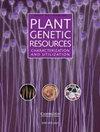Allelic diversity of a panel of Aegilops mutica Boiss (Amblyopyrym muticum (Boiss.) Eig) from Turkey
IF 0.7
4区 生物学
Q3 PLANT SCIENCES
Plant Genetic Resources: Characterization and Utilization
Pub Date : 2022-11-08
DOI:10.1017/s1479262122000235
引用次数: 1
Abstract
The members of the Aegilops genus serve as a vast pool of allele discovery for wheat improvement in abiotic and biotic stress responses. Aegilops mutica Boiss (Amblyopyrym muticum (Boiss) Eig) is an unexplored candidate with significant potential. Even though it has been used in cytogenetics applications within the last century, natural population diversity and allele discovery have been neglected. As an endemic species for Anatolia and the lower Caucasian region, it has an unexplored population structure. Here, seventy-five genotypes from five different newly collected populations from central Anatolia were evaluated with 29 polymorphic SSR loci. Significant diversity within (83%) and between (17%) the populations was obtained. Three of the populations were clearly separated, while two had some level of the mixture. Relatively easy cross-species hybridization and introgressions make Ae. mutica a good candidate for novel allele discovery and pre-breeding. Here, for the first time, representative natural populations of Ae. mutica were compared and population structures were revealed with SSR markers which may clear the misty vision that geneticists might have regarding Ae. mutica. This could be exploited in genetic resource conservation and breeding programs and maybe a point for further studies.一组绿盾(Amblyopyrym muticum)的等位基因多样性来自土耳其
Aegilops属的成员为小麦改善非生物和生物胁迫反应提供了巨大的等位基因发现库。Amblyopyrym muticum (Boiss) Eig是一种未开发的候选物种,具有重要的潜力。尽管它在上个世纪已被用于细胞遗传学应用,但自然种群多样性和等位基因的发现却被忽视了。作为安纳托利亚和下高加索地区的特有种,其种群结构尚未开发。本研究利用29个SSR多态性位点对新收集的5个安纳托利亚中部群体的75个基因型进行了分析。种群内(83%)和种群间(17%)具有显著的多样性。其中三个种群明显分离,而两个种群有一定程度的混合。相对容易的跨种杂交和渐渗使伊蚊。Mutica是新等位基因发现和预育种的良好候选者。在这里,第一次有代表性的伊蚊自然种群。利用SSR标记对伊蚊的种群结构进行了比较和揭示,这可能会消除遗传学家对伊蚊的模糊认识。mutica。这可以在遗传资源保护和育种计划中加以利用,并可能成为进一步研究的重点。
本文章由计算机程序翻译,如有差异,请以英文原文为准。
求助全文
约1分钟内获得全文
求助全文
来源期刊

Plant Genetic Resources: Characterization and Utilization
Agricultural and Biological Sciences-Agronomy and Crop Science
CiteScore
2.80
自引率
0.00%
发文量
29
审稿时长
>12 weeks
期刊介绍:
Plant Genetic Resources is an international journal which provides a forum for describing the application of novel genomic technologies, as well as their integration with established techniques, towards the understanding of the genetic variation captured in both in situ and ex situ collections of crop and non-crop plants; and for the airing of wider issues relevant to plant germplasm conservation and utilisation. We particularly welcome multi-disciplinary approaches that incorporate both a technical and a socio-economic focus. Technical aspects can cover developments in technologies of potential or demonstrated relevance to the analysis of variation and diversity at the phenotypic and genotypic levels.
 求助内容:
求助内容: 应助结果提醒方式:
应助结果提醒方式:


